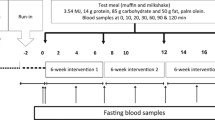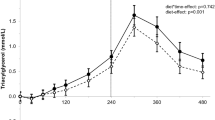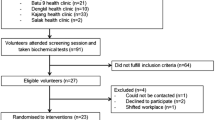Abstract
Palm oil that has been interesterified to produce a higher proportion of palmitic acid (16:0) in the sn-2 position reduces postprandial lipemia in young, normolipidemic men and women, but effects in older subjects with higher fasting triacylglycerol (TAG) concentrations are unknown. We tested the hypothesis that high-fat meals rich in interesterified palm olein (IPO) decrease lipemia and alter plasma lipoprotein fraction composition compared to native palm olein (NPO) in men aged 40–70 years with fasting TAG concentrations ≥1.2 mmol/L. Postprandial changes in plasma lipids following meals containing 75 g fat (NPO and IPO) were compared using a randomized, double-blind crossover design (n = 11). Although there were no significant differences in plasma TAG concentrations between meals over the total 6-h postprandial measurement period, IPO resulted in a decreased plasma TAG response during the first 4 h of the postprandial period (iAUC 1.65 mmol/L h, 95 % CI 1.01–2.29) compared to NPO (iAUC 2.33 mmol/L h, 95 % CI 1.58–3.07); meal effect P = 0.024. Chylomicron fraction TAG concentrations at 4–6 h were slightly reduced following IPO compared to NPO [NPO−IPO mean difference 0.29 mmol/L (95 % CI −0.01–0.59), P = 0.055]. There were no differences in IDL fraction TAG, cholesterol or apolipoprotein B48 concentrations following IPO compared with NPO. In conclusion, consuming a meal containing palm olein with a higher proportion of 16:0 in the sn-2 position decreases postprandial lipemia compared to native palm olein during the early phase of the postprandial period in men with higher than optimal fasting triacylglycerol concentrations.


Similar content being viewed by others
Abbreviations
- iAUC:
-
Incremental area under the curve
- DVP:
-
Digital volume pulse
- IPO:
-
Interesterified palm olein
- NEFA:
-
Non-esterified fatty acids
- NPO:
-
Native palm olein
- TAG:
-
Triacylglycerol
References
Jackson KG, Poppitt SD, Minihane AM (2012) Postprandial lipemia and cardiovascular disease risk: interrelationships between dietary, physiological and genetic determinants. Atherosclerosis 220:22–33
Bansal S, Buring JE, Rifai N, Mora S, Sacks FM, Ridker PM (2007) Fasting compared with nonfasting triglycerides and risk of cardiovascular events in women. JAMA 298:309–316
Nordestgaard BG, Benn M, Schnohr P, Tybjaerg-Hansen A (2007) Nonfasting triglycerides and risk of myocardial infarction, ischemic heart disease, and death in men and women. JAMA 298:299–308
Lindman AS, Veierod MB, Tverdal A, Pedersen JI, Selmer R (2010) Nonfasting triglycerides and risk of cardiovascular death in men and women from the Norwegian Counties Study. Eur J Epidemiol 25:789–798
Berry SE (2009) Triacylglycerol structure and interesterification of palmitic and stearic acid-rich fats: an overview and implications for cardiovascular disease. Nutr Res Rev 22:3–17
Berry SE, Miller GJ, Sanders TA (2007) The solid fat content of stearic acid-rich fats determines their postprandial effects. Am J Clin Nutr 85:1486–1494
Berry SE, Woodward R, Yeoh C, Miller GJ, Sanders TA (2007) Effect of interesterification of palmitic acid-rich triacylglycerol on postprandial lipid and factor VII response. Lipids 42:315–323
Sundram K, Karupaiah T, Hayes KC (2007) Stearic acid-rich interesterified fat and trans-rich fat raise the LDL/HDL ratio and plasma glucose relative to palm olein in humans. Nutr Metab 4:3
Hayes KC, Pronczuk A (2010) Replacing trans fat: the argument for palm oil with a cautionary note on interesterification. J Am Coll Nutr 29:253S–284S
Sanders TA, Filippou A, Berry SE, Baumgartner S, Mensink RP (2011) Palmitic acid in the sn-2 position of triacylglycerols acutely influences postprandial lipid metabolism. Am J Clin Nutr 94:1433–1441
Kritchevsky D, Tepper SA, Chen SC, Meijer GW, Krauss RM (2000) Cholesterol vehicle in experimental atherosclerosis. 23. Effects of specific synthetic triglycerides. Lipids 35:621–625
Zock PL, de Vries JH, de Fouw NJ, Katan MB (1995) Positional distribution of fatty acids in dietary triglycerides: effects on fasting blood lipoprotein concentrations in humans. Am J Clin Nutr 61:48–55
Nestel PJ, Noakes M, Belling GB, McArthur R, Clifton PM (1995) Effect on plasma lipids of interesterifying a mix of edible oils. Am J Clin Nutr 62:950–955
Yli-Jokipii K, Kallio H, Schwab U, Mykkanen H, Kurvinen JP, Savolainen MJ, Tahvonen R (2001) Effects of palm oil and transesterified palm oil on chylomicron and VLDL triacylglycerol structures and postprandial lipid response. J Lipid Res 42:1618–1625
Sanders TA, Oakley FR, Cooper JA, Miller GJ (2001) Influence of a stearic acid-rich structured triacylglycerol on postprandial lipemia, factor VII concentrations, and fibrinolytic activity in healthy subjects. Am J Clin Nutr 73:715–721
Terpstra AH, Woodward CJ, Sanchez-Muniz FJ (1981) Improved techniques for the separation of serum lipoproteins by density gradient ultracentrifugation: visualization by prestaining and rapid separation of serum lipoproteins from small volumes of serum. Anal Biochem 111:149–157
Terpstra AH (1985) Isolation of serum chylomicrons prior to density gradient ultracentrifugation of other serum lipoprotein classes. Anal Biochem 150:221–227
Lepage G, Roy CC (1986) Direct transesterification of all classes of lipids in a one-step reaction. J Lipid Res 27:114–120
Sanders TA, Berry SE, Miller GJ (2003) Influence of triacylglycerol structure on the postprandial response of factor VII to stearic acid-rich fats. Am J Clin Nutr 77:777–782
Boren J, Matikainen N, Adiels M, Taskinen MR (2014) Postprandial hypertriglyceridemia as a coronary risk factor. Clinica Chimica Acta; Int J Clin Chem 431C:131–142
Varbo A, Benn M, Tybjaerg-Hansen A, Jorgensen AB, Frikke-Schmidt R, Nordestgaard BG (2013) Remnant cholesterol as a causal risk factor for ischemic heart disease. J Am Coll Cardiol 61:427–436
Jackson KG, Knapper-Francis JME, Morgan LM, Webb DH, Zampelas A, Williams CM (2003) Exaggerated postprandial lipaemia and lower post-heparin lipoprotein lipase activity in middle-aged men. Clin Sci (Lond, Engl: 1979) 105:457–466
Varbo A, Benn M, Tybjaerg-Hansen A, Nordestgaard BG (2013) Elevated remnant cholesterol causes both low-grade inflammation and ischemic heart disease, whereas elevated low-density lipoprotein cholesterol causes ischemic heart disease without inflammation. Circulation 128:1298–1309
Acknowledgments
This study was funded by King’s College London. We thank Tracy Dew (King’s College Hospital), and Robert Gray, Anne Catherine-Perz, Sarah Cottin, Fawaz Alzaid and Jai David (King’s College London) for their assistance with sample processing and analysis during the study. Fats were provided by Intercontinental Specialty Fats, Selangor, Malaysia and Wilmar PGEO Edible Oils, Johor, Malaysia. The authors’ responsibilities were as follows—WLH, SEB, and TABS: conceived and devised the study and contributed to the running of the study and analysis and writing of the manuscript; MFB, JH, LVW, AF: organized and conducted the study (including recruitment, enrolment, assignment to intervention, conducting study days) at King’s College London and contributed to sample analysis and writing the manuscript. Thomas Sanders is a member of the Programme Advisory Committee of the Malaysian Palm Oil Board, a member of the Scientific Advisory Committee of the Global Dairy Platform.
Author information
Authors and Affiliations
Corresponding author
Electronic supplementary material
Below is the link to the electronic supplementary material.
About this article
Cite this article
Hall, W.L., Fiuza Brito, M., Huang, J. et al. An Interesterified Palm Olein Test Meal Decreases Early-Phase Postprandial Lipemia Compared to Palm Olein: a Randomized Controlled Trial. Lipids 49, 895–904 (2014). https://doi.org/10.1007/s11745-014-3936-1
Received:
Accepted:
Published:
Issue Date:
DOI: https://doi.org/10.1007/s11745-014-3936-1




